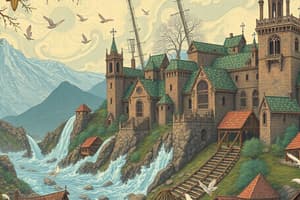Podcast
Questions and Answers
What is the primary cause of coastal flooding?
What is the primary cause of coastal flooding?
- Rapid snowmelt
- Overbuilt drainage systems
- Heavy rainfall
- Storm surges and rising sea levels (correct)
Which term refers to a storm occurring over the North Atlantic Ocean?
Which term refers to a storm occurring over the North Atlantic Ocean?
- Tornado
- Cyclone
- Typhoon
- Hurricane (correct)
What phenomenon occurs when the surface waters of the Pacific Ocean become warmer than usual?
What phenomenon occurs when the surface waters of the Pacific Ocean become warmer than usual?
- Weather Front
- Monsoon
- La Niña
- El Niño (correct)
What defines a tornado?
What defines a tornado?
What natural disaster can result from storm surges and cyclones originating in the Pacific Ocean?
What natural disaster can result from storm surges and cyclones originating in the Pacific Ocean?
Which term best defines a natural disaster?
Which term best defines a natural disaster?
What is the primary cause of flash floods?
What is the primary cause of flash floods?
Which of the following is true about the 1931 Yellow River flood?
Which of the following is true about the 1931 Yellow River flood?
Which type of natural disaster is characterized by being the most frequent?
Which type of natural disaster is characterized by being the most frequent?
What factors contribute to the occurrence of floods?
What factors contribute to the occurrence of floods?
Flashcards are hidden until you start studying
Study Notes
Understanding Disasters
- Definition of Disaster: A sudden event causing significant damage or loss, which can be accidental or a natural catastrophe.
- Types of Disasters: Include emergencies, apocalypses, calamities, cataclysms, catastrophes, and natural disasters.
- Natural Disasters: Catastrophic events stemming from natural phenomena on Earth, inflicting massive damage or loss of life, typically rare occurrences.
Classification of Natural Disasters
- Natural disasters are often classified based on their origin, including hydro-meteorological events.
Hydro-Meteorological Natural Disasters
- Floods: The most common natural disaster, caused by heavy rainfall, snowmelt, or storm surges, submerging typically dry land.
- Flash Floods: Rapid water rise in streams or urban areas, due to intense rainfall overwhelming drainage systems.
- Coastal Floods: Flooding in low-lying coastal areas, often due to storm surges from tropical storms, rising sea levels, or tsunamis.
Storms
- Cyclones, Hurricanes, and Typhoons: Terminology is location-specific. Cyclones occur in the Indian Ocean, hurricanes in the Atlantic, and typhoons in the Pacific.
- Tornadoes: Violently rotating columns of air, forming a contact point with the ground and a cumulonimbus cloud.
El Niño and La Niña
- El Niño: Warm ocean waters in the Pacific can lead to various climate impacts globally, including flooding and droughts in different regions, altering weather patterns drastically.
- Normal Year Conditions: Defined by high pressure in the eastern Pacific and low pressure in the western Pacific, resulting in standard trade winds and weather conditions.
- La Niña: Involves cooler subsurface waters in the eastern Pacific, leading to severe droughts in South America and increased rainfall in northern Australia.
Global Impacts of El Niño and La Niña
- El Niño Effects: Increased flooding in South America, drier conditions in Amazonia, and reduced monsoon strength in Asia.
- La Niña Effects: Severe weather events like flooding in Australia and snowstorms in North America.
Droughts and Wildfires
- Drought: Extended periods lacking precipitation, impacting ecosystems and agriculture, can cause significant loss of life (e.g., India in 1900).
- Wildfires: Uncontrolled outdoor fires occurring in forests or grasslands, spreading due to environmental conditions.
Heat Waves and Extreme Temperatures
- Heat Waves: Extended periods of excessively high temperatures affecting crops, animals, and human health.
- Factors increasing heat-related illnesses include humidity, obesity, and dehydration.
Human-Caused Disasters
- Result from human activities, including oil spills, chemical explosions, and gas leaks.
Natural Disasters in Sri Lanka
- Common occurrences include heavy rains, floods, landslides, heat waves, droughts, tornadoes, cyclones, volcanoes, earthquakes, tsunamis, winter storms, and wildfires.
Disaster Prevention (Sendai Seven Campaign)
- Campaign Goals: Reducing disaster mortality, affected populations, economic losses, and overall disaster damage while promoting awareness and preparedness by 2022.
- Mitigation Strategies: Emphasize zoning, land-use practices, building codes, and international cooperation to enhance disaster response.
Economic Impact
- Disasters in 2022 significantly totaled over $130 billion in economic losses due to weather-related events.
Studying That Suits You
Use AI to generate personalized quizzes and flashcards to suit your learning preferences.




